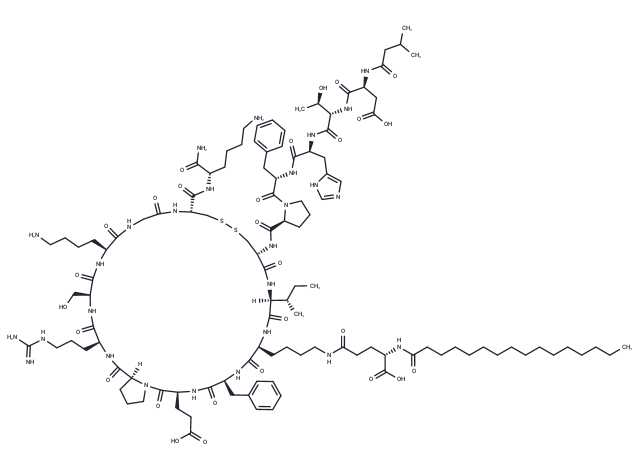Shopping Cart
- Remove All
 Your shopping cart is currently empty
Your shopping cart is currently empty

Rusfertide, a peptide mimetic of natural hepcidin, targets and degrades ferroportin, thereby reducing serum iron and transferrin saturation, which helps regulate red blood cell production. It ameliorates conditions such as polycythemia vera, β-thalassemia, and hereditary hemochromatosis [1] [2].

| Pack Size | Price | Availability | Quantity |
|---|---|---|---|
| 10 mg | Inquiry | Inquiry | |
| 50 mg | Inquiry | Inquiry |
| Description | Rusfertide, a peptide mimetic of natural hepcidin, targets and degrades ferroportin, thereby reducing serum iron and transferrin saturation, which helps regulate red blood cell production. It ameliorates conditions such as polycythemia vera, β-thalassemia, and hereditary hemochromatosis [1] [2]. |
| In vivo | Rusfertide reduces iron toxicity within red blood cells (RBCs) at a dosage of 1 mg/kg administered subcutaneously every two days for 49 days and decreases transferrin saturation at 2.5 mg/kg under the same administration schedule for two weeks. This enhances the oxygen-carrying capacity of RBCs and ameliorates anemia and iron accumulation in β-thalassemia and hereditary hemochromatosis mouse models [1]. Animal Model: Hbb th3/+ mice model for β-thalassemia and hereditary hemochromatosis [1] Dosage: 1 and 2.5 mg/kg Administration: s.c., once every two days, for 49 days (1 mg/kg); or for 2 weeks (2.5 mg/kg) Result: Improved the survival rate of RBCs in β-thalassemia model. Reduced transferrin-saturation and iron deposition. |
| Alias | PTG-300 |
| Molecular Weight | 2441.95 |
| Formula | C114H181N27O28S2 |
| Cas No. | 1628323-80-7 |
| Storage | Powder: -20°C for 3 years | In solvent: -80°C for 1 year | Shipping with blue ice. |

Copyright © 2015-2025 TargetMol Chemicals Inc. All Rights Reserved.